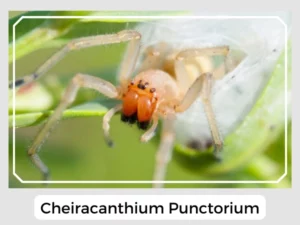Cheiracanthium, or yellow sac spiders, are pretty special. They’re the biggest group in their family (Cheiracanthiidae) with a whopping 200 types! While most live in the Old World, a few like the northern yellow sac spider and the black-footed yellow sac spider call the New World home.
The female spiders produce about five egg sacs in one go, with 30 – 48 eggs in each of them. The eggs laid in autumn are covered in a silken sac.
The spiderlings hatch the following spring and stay inside the silken sac till they develop the ability to find food for themselves independently.
They do not build webs but construct a sac or silken tube within a leaf, woodpiles, or any protected area to take shelter during the day.
Yes, Cheiracanthium spiders, also called yellow sac spiders, have venom. But for most people, it’s not super harmful. They use it to help catch their food.
Yes, Cheiracanthium spiders can bite. They might bite if they feel threatened. The bite might be a bit itchy or leave a small red mark, but it’s not usually very bad. The results of a study conducted in Australia and the United States deduced that the bites of these spiders did not result in necrosis (death of body tissues).
Cheiracanthium spiders play a vital role in the balance of ecosystems by helping control populations of insects and other spiders. They exhibit nocturnal hunting behavior, actively pursuing their prey during the night and seeking refuge in their silken sacs during the day.
Natural Predators: While specific natural predators of Cheiracanthium spiders are not well documented, it is likely that they fall prey to larger spiders, birds, and insectivorous mammals.
Prey-Predator Dynamics: As predators, Cheiracanthium spiders contribute to the regulation of insect and spider populations in their habitats. Their hunting efficiency is enhanced by their venom, which helps them subdue prey quickly.
Relationship with Humans: Cheiracanthium spiders often venture close to human habitations, which can lead to encounters. While their bites are generally harmless, it is crucial for people to be aware of these spiders and understand their behavior to prevent unwanted bites. Their presence, however, can be beneficial as they help control pest populations.
| Other Names | Yellow sac spiders |
| Distribution | Old World: Northern Europe, Southern Africa, Australia, India, Japan New World: Argentina, British Columbia, Canada |
| Habitat | Cotton field, backyard, unused houses and garages |
| Diet | Spiders and other small insects |
| Lifespan | 1-2 years |

In summary, the Cheiracanthium spiders, with their wide distribution and diverse habitats, are a remarkable group within the arachnid kingdom.
Cheiracanthium, or yellow sac spiders, are pretty special. They’re the biggest group in their family (Cheiracanthiidae) with a whopping 200 types! While most live in the Old World, a few like the northern yellow sac spider and the black-footed yellow sac spider call the New World home.
The female spiders produce about five egg sacs in one go, with 30 – 48 eggs in each of them. The eggs laid in autumn are covered in a silken sac.
The spiderlings hatch the following spring and stay inside the silken sac till they develop the ability to find food for themselves independently.
They do not build webs but construct a sac or silken tube within a leaf, woodpiles, or any protected area to take shelter during the day.
Yes, Cheiracanthium spiders, also called yellow sac spiders, have venom. But for most people, it’s not super harmful. They use it to help catch their food.
Yes, Cheiracanthium spiders can bite. They might bite if they feel threatened. The bite might be a bit itchy or leave a small red mark, but it’s not usually very bad. The results of a study conducted in Australia and the United States deduced that the bites of these spiders did not result in necrosis (death of body tissues).
Cheiracanthium spiders play a vital role in the balance of ecosystems by helping control populations of insects and other spiders. They exhibit nocturnal hunting behavior, actively pursuing their prey during the night and seeking refuge in their silken sacs during the day.
Natural Predators: While specific natural predators of Cheiracanthium spiders are not well documented, it is likely that they fall prey to larger spiders, birds, and insectivorous mammals.
Prey-Predator Dynamics: As predators, Cheiracanthium spiders contribute to the regulation of insect and spider populations in their habitats. Their hunting efficiency is enhanced by their venom, which helps them subdue prey quickly.
Relationship with Humans: Cheiracanthium spiders often venture close to human habitations, which can lead to encounters. While their bites are generally harmless, it is crucial for people to be aware of these spiders and understand their behavior to prevent unwanted bites. Their presence, however, can be beneficial as they help control pest populations.
| Other Names | Yellow sac spiders |
| Distribution | Old World: Northern Europe, Southern Africa, Australia, India, Japan New World: Argentina, British Columbia, Canada |
| Habitat | Cotton field, backyard, unused houses and garages |
| Diet | Spiders and other small insects |
| Lifespan | 1-2 years |

In summary, the Cheiracanthium spiders, with their wide distribution and diverse habitats, are a remarkable group within the arachnid kingdom.